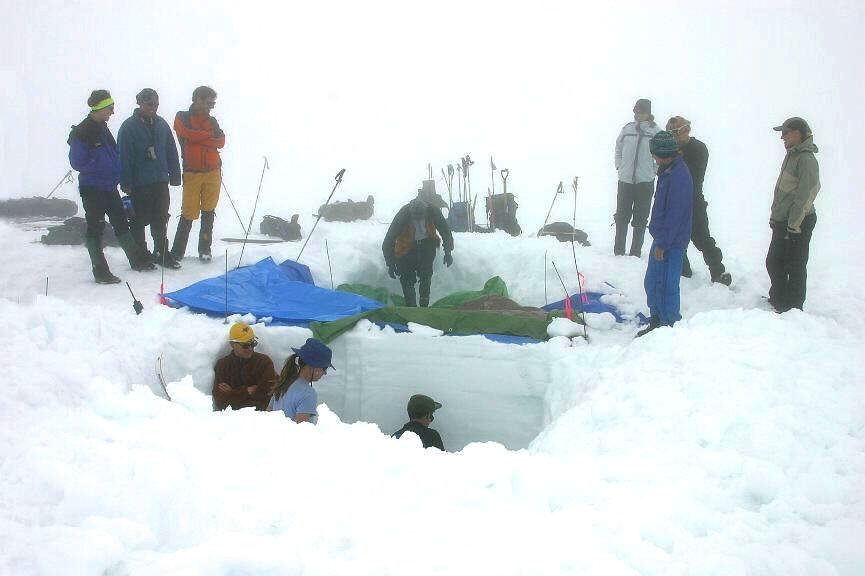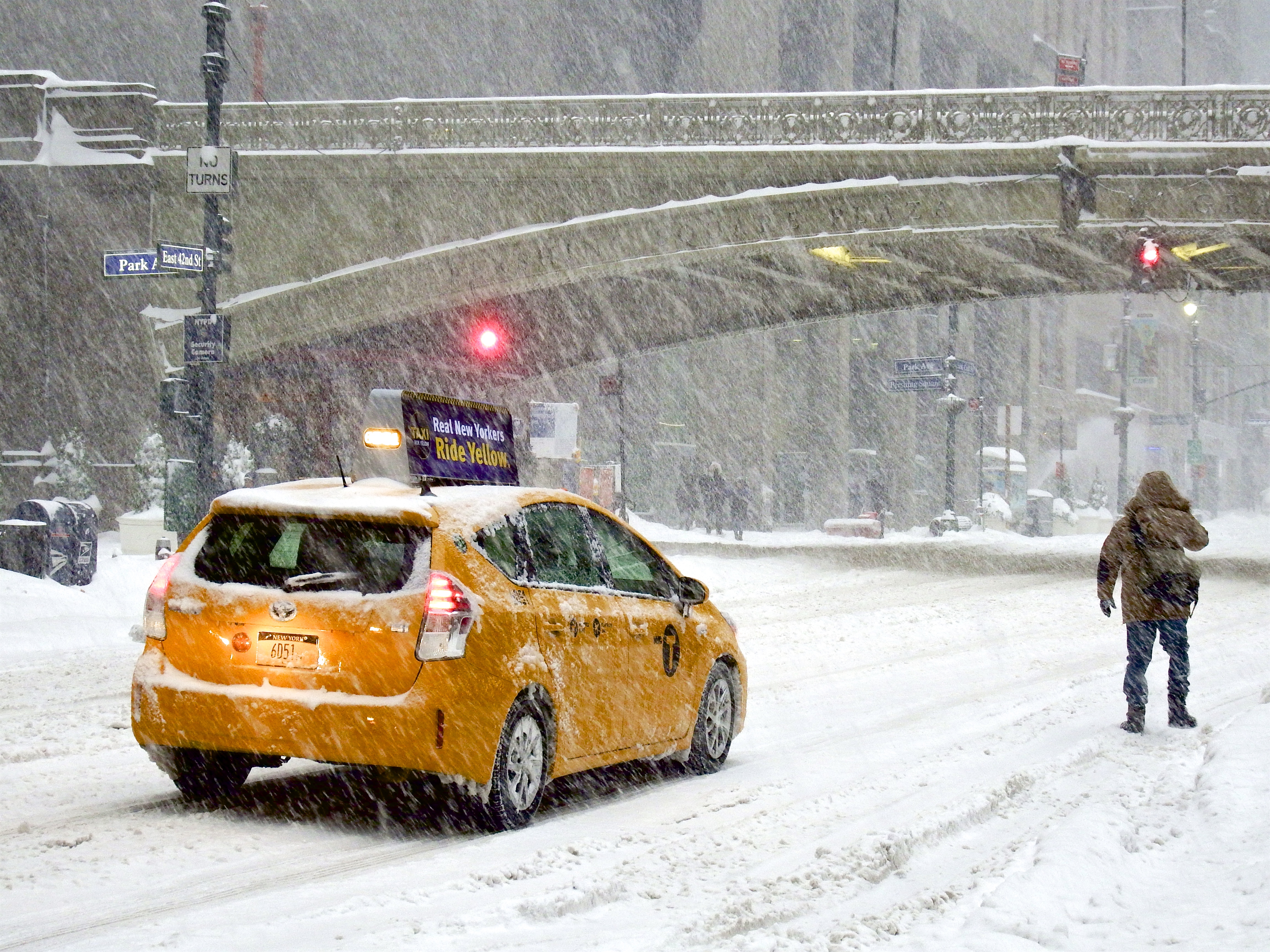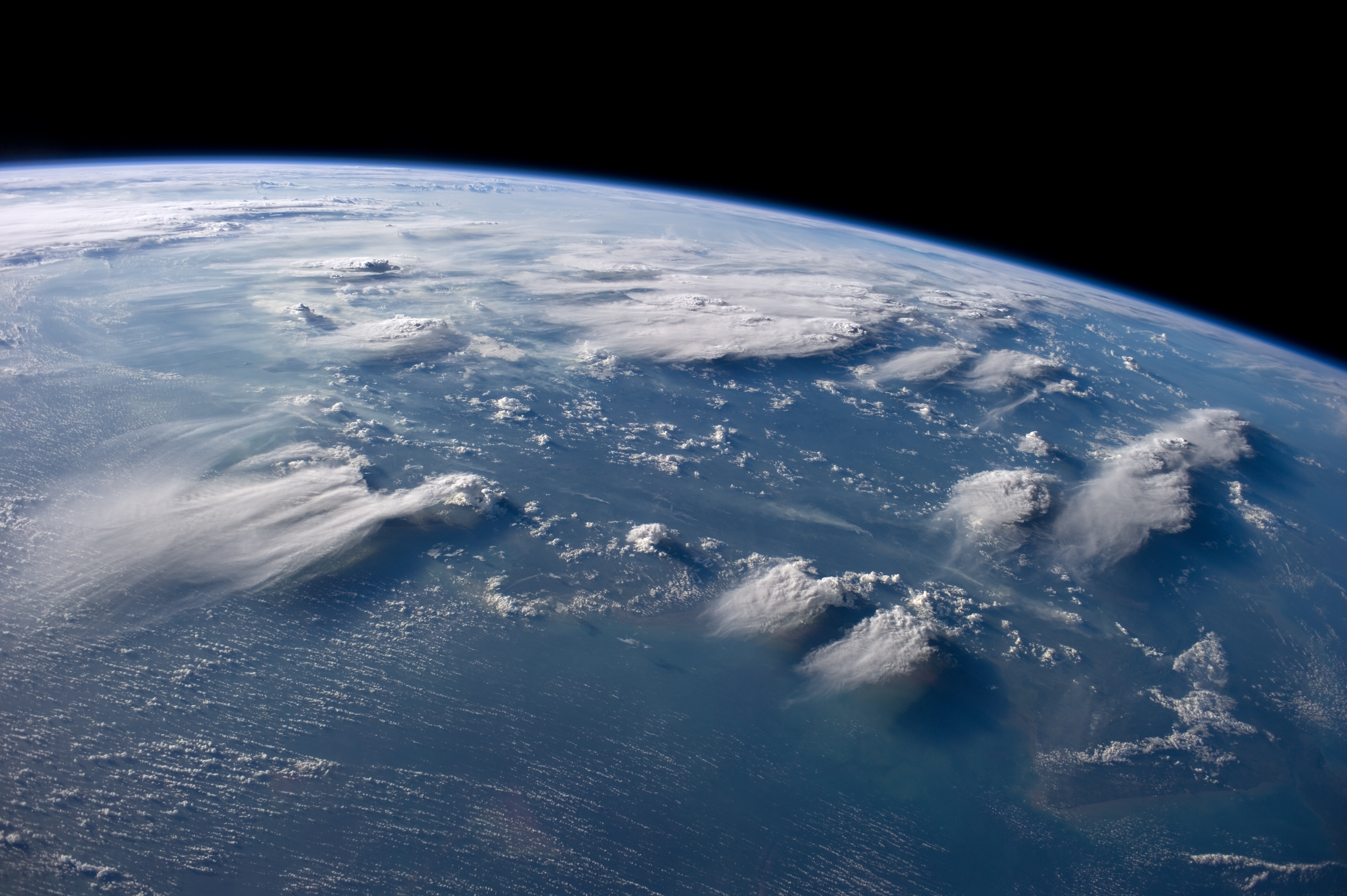|
Snow
Snow consists of individual ice crystals that grow while suspended in the atmosphere—usually within clouds—and then fall, accumulating on the ground where they undergo further changes. It consists of frozen crystalline water throughout its life cycle, starting when, under suitable conditions, the ice crystals form in the atmosphere, increase to millimeter size, precipitate and accumulate on surfaces, then metamorphose in place, and ultimately melt, slide, or Sublimation (phase transition), sublimate away. Snowstorms organize and develop by feeding on sources of atmospheric moisture and cold air. Snowflakes Nucleation, nucleate around particles in the atmosphere by attracting supercooling, supercooled water droplets, which Freezing, freeze in hexagonal-shaped crystals. Snowflakes take on a variety of shapes, basic among these are platelets, needles, columns, and Hard rime, rime. As snow accumulates into a snowpack, it may blow into drifts. Over time, accumulated snow m ... [...More Info...] [...Related Items...] OR: [Wikipedia] [Google] [Baidu] |
Snowboarding
Snowboarding is a recreational and competitive activity that involves descending a snow-covered surface while standing on a snowboard that is almost always attached to a rider's feet. It features in the Winter Olympic Games and Winter Paralympic Games. Snowboarding was developed in the United States, inspired by skateboarding, sledding, surfing, and skiing. It became popular around the world and was introduced as a Winter Olympic Sport at Nagano in 1998 and featured in the Winter Paralympics at Sochi in 2014. , its popularity (as measured by equipment sales) in the United States peaked in 2007 and has been in a decline since. History The first snowboards were developed in 1965 when Sherm Poppen, an engineer in Muskegon, Michigan, invented a toy for his daughters by fastening two skis together and attaching a rope to one end so he would have some control as they stood on the board and glided downhill. Dubbed the "snurfer" (combining snow and surfer) by his wife Nancy ... [...More Info...] [...Related Items...] OR: [Wikipedia] [Google] [Baidu] |
Snowflake
A snowflake is a single ice crystal that is large enough to fall through the Earth's atmosphere as snow.Knight, C.; Knight, N. (1973). Snow crystals. Scientific American, vol. 228, no. 1, pp. 100–107.Hobbs, P.V. 1974. Ice Physics. Oxford: Clarendon Press. Snow appears white in color despite being made of clear ice. This is because the many small crystal facets of the snowflakes scatter the sunlight between them. Each flake begins by forming around a tiny particle, called its nucleus, accumulating water droplets, which freeze and slowly form a crystal. Complex shapes emerge as the flake moves through differing temperature and humidity zones in the atmosphere, and possibly combines with other snowflakes. Because of this, snowflakes tend to look very different from one another. However, they may be categorized in eight broad classifications and at least 80 individual variants. The main constituent shapes for ice crystals, from which combinations may occur, are ''needle'' ... [...More Info...] [...Related Items...] OR: [Wikipedia] [Google] [Baidu] |
Snowmobile
A snowmobile, also known as a snowmachine (chiefly Alaskan), motor sled (chiefly Canadian), motor sledge, skimobile, snow scooter, or simply a sled is a motorized vehicle designed for winter travel and recreation on snow. Their engines normally drive a continuous track at the rear, while skis at the front provide directional control. The earliest snowmobiles were powered by readily available industrial four-stroke, air-cooled engines. These would quickly be replaced by lighter and more powerful two-stroke gasoline internal combustion engines and since the mid-2000s four-stroke engines had re-entered the market. The challenges of cross-country transportation in the winter led to the invention of an all-terrain vehicle specifically designed for travel across deep snow where other vehicles foundered. , the snowmobile market has been shared between the four large North American makers (Bombardier Recreational Products (BRP), Arctic Cat, Yamaha, and Polaris) and some specialized m ... [...More Info...] [...Related Items...] OR: [Wikipedia] [Google] [Baidu] |
Snowpack
Snowpack is an accumulation of snow that compresses with time and melts seasonally, often at high elevation or high latitude. Snowpacks are an important water resource that feed streams and rivers as they melt, sometimes leading to flooding. Snowpacks provide water to down-slope communities for drinking and agriculture. High-latitude or high-elevation snowpacks contribute mass to glaciers in their accumulation zones, where annual snow deposition exceeds annual melting. Assessing the formation and stability of snowpacks is important in the study and prediction of avalanches. Scientists study the physical properties of snow under different conditions and their evolution, and more specifically snow metamorphism, snow hydrology (that is, the contribution of snow melt to catchment hydrology), the evolution of snow cover with climate change and its effect on the ice–albedo feedback and hydrology, both on the ground and by using remote sensing. Snow is also studied in a more global c ... [...More Info...] [...Related Items...] OR: [Wikipedia] [Google] [Baidu] |
Snowstorm
A winter storm (also known as snow storm) is an event in which wind coincides with varieties of precipitation that only occur at freezing temperatures, such as snow, Rain and snow mixed, mixed snow and rain, or freezing rain. In Continental climate, temperate continental and subarctic climates, these storms are not necessarily restricted to the winter season, but may occur in the late autumn and early spring as well. A snowstorm with strong winds and low visibility is called a blizzard. Formation Winter storms are formed when moist air rises up into the atmosphere, creating Low-pressure area, low pressure near the ground and clouds up in the air. The air can also be pushed upwards by hills or large mountains. The upward motion is called Lift (force), lift. The moisture is collected by the wind from large bodies of water, such as a big lake or the ocean. If temperature is below freezing, , near the ground and up in the clouds, precipitation will fall as snow, ice, rain and s ... [...More Info...] [...Related Items...] OR: [Wikipedia] [Google] [Baidu] |
Glacier
A glacier (; or ) is a persistent body of dense ice, a form of rock, that is constantly moving downhill under its own weight. A glacier forms where the accumulation of snow exceeds its ablation over many years, often centuries. It acquires distinguishing features, such as crevasses and seracs, as it slowly flows and deforms under stresses induced by its weight. As it moves, it abrades rock and debris from its substrate to create landforms such as cirques, moraines, or fjords. Although a glacier may flow into a body of water, it forms only on land“Glacier, N., Pronunciation.” Oxford English Dictionary, Oxford UP, June 2024, https://doi.org/10.1093/OED/7553486115. Accessed 25 Jan. 2025. and is distinct from the much thinner sea ice and lake ice that form on the surface of bodies of water. On Earth, 99% of glacial ice is contained within vast ice sheets (also known as "continental glaciers") in the polar regions, but glaciers may be found in mountain ranges on ever ... [...More Info...] [...Related Items...] OR: [Wikipedia] [Google] [Baidu] |
Extratropical Cyclone
Extratropical cyclones, sometimes called mid-latitude cyclones or wave cyclones, are low-pressure areas which, along with the anticyclones of high-pressure areas, drive the weather over much of the Earth. Extratropical cyclones are capable of producing anything from cloudiness and mild rain, showers to severe hail, thunderstorms, blizzards, and tornadoes. These types of cyclones are defined as Synoptic scale meteorology, large scale (synoptic) Low-pressure area, low pressure weather systems that occur in the middle latitudes of the Earth. In contrast with tropical cyclones, extratropical cyclones produce rapid changes in temperature and dew point along broad lines, called weather fronts, about the center of the cyclone. Terminology The term "cyclone" applies to numerous types of low pressure areas, one of which is the extratropical cyclone. The descriptor ''extratropical'' signifies that this type of cyclone generally occurs outside the tropics and in the middle latitudes of Ea ... [...More Info...] [...Related Items...] OR: [Wikipedia] [Google] [Baidu] |
Skiing
Skiing is the use of skis to glide on snow for basic transport, a recreational activity, or a competitive winter sport. Many types of competitive skiing events are recognized by the International Olympic Committee (IOC), and the International Ski and Snowboard Federation (FIS). History Skiing has a history of almost five millennia. Although modern skiing has evolved from beginnings in Scandinavia, it may have been practiced more than 100 centuries ago in the Altai Mountains, according to an interpretation of ancient paintings. However, this continues to be debated. The word "ski" comes from the Old Norse word "skíð" which means to "split piece of wood or firewood". Asymmetrical skis were used in northern Finland and Sweden until at least the late 19th century. On one foot, the skier wore a long straight non-arching ski for sliding, and a shorter ski was worn on the other foot for kicking. The underside of the short ski was either plain or covered with animal skin to aid ... [...More Info...] [...Related Items...] OR: [Wikipedia] [Google] [Baidu] |
Hard Rime
Rime ice forms when supercooled water droplets freeze onto surfaces. In the atmosphere, there are three basic types of rime ice: *Soft rime forms when supercooled water freezes under calm wind conditions. It is milky and crystalline, like sugar, and similar to hoar frost. *Hard rime forms by rapid freezing of supercooled water under at least moderate wind conditions. The droplets freeze more or less individually, leaving air gaps. *Clear ice forms by slow freezing of supercooled water. Clear ice is typically transparent and homogeneous. Its amorphous and dense structure makes it adhesive. Soft and hard rime are less dense than clear ice and less adhesive, thus generally cause less damage. Glaze ice is similar in appearance to clear ice, however it is the result of a completely different process, occurring during freezing rain or drizzle. Rime ice also forms when ice forms on the surface of an aircraft, particularly on the leading edges and control surfaces when it flies thr ... [...More Info...] [...Related Items...] OR: [Wikipedia] [Google] [Baidu] |
Antarctica
Antarctica () is Earth's southernmost and least-populated continent. Situated almost entirely south of the Antarctic Circle and surrounded by the Southern Ocean (also known as the Antarctic Ocean), it contains the geographic South Pole. Antarctica is the fifth-largest continent, being about 40% larger than Europe, and has an area of . Most of Antarctica is covered by the Antarctic ice sheet, with an average thickness of . Antarctica is, on average, the coldest, driest, and windiest of the continents, and it has the highest average elevation. It is mainly a polar desert, with annual Climate of Antarctica#Precipitation, precipitation of over along the coast and far less inland. About 70% of the world's freshwater reserves are frozen in Antarctica, which, if melted, would raise global sea levels by almost . Antarctica holds the record for the Lowest temperature recorded on Earth, lowest measured temperature on Earth, . The coastal regions can reach temperatures over in the ... [...More Info...] [...Related Items...] OR: [Wikipedia] [Google] [Baidu] |
Cloud
In meteorology, a cloud is an aerosol consisting of a visible mass of miniature liquid droplets, frozen crystals, or other particles, suspended in the atmosphere of a planetary body or similar space. Water or various other chemicals may compose the droplets and crystals. On Earth, clouds are formed as a result of saturation of the air when it is cooled to its dew point, or when it gains sufficient moisture (usually in the form of water vapor) from an adjacent source to raise the dew point to the ambient temperature. Clouds are seen in the Earth's homosphere, which includes the troposphere, stratosphere, and mesosphere. Nephology is the science of clouds, which is undertaken in the cloud physics branch of meteorology. The World Meteorological Organization uses two methods of naming clouds in their respective layers of the homosphere, Latin and common name. Genus types in the troposphere, the atmospheric layer closest to Earth's surface, have Latin names because of th ... [...More Info...] [...Related Items...] OR: [Wikipedia] [Google] [Baidu] |
Polar Regions Of Earth
The polar regions, also called the frigid zones or polar zones, of Earth are Earth's polar ice caps, the regions of the planet that surround its geographical poles (the North and South Poles), lying within the polar circles. These high latitudes are dominated by floating sea ice covering much of the Arctic Ocean in the north, and by the Antarctic ice sheet on the continent of Antarctica and the Southern Ocean in the south. Definitions The Arctic has various definitions, including the region north of the Arctic Circle (currently Epoch 2010 at 66°33'44" N), or just the region north of 60° north latitude, or the region from the North Pole south to the timberline. The Antarctic is usually defined simply as south of 60° south latitude, or the continent of Antarctica. The 1959 Antarctic Treaty uses the former definition. The two polar regions are distinguished from the other two climatic and biometric belts of Earth, a tropics belt near the equator, and two middle latitude ... [...More Info...] [...Related Items...] OR: [Wikipedia] [Google] [Baidu] |










